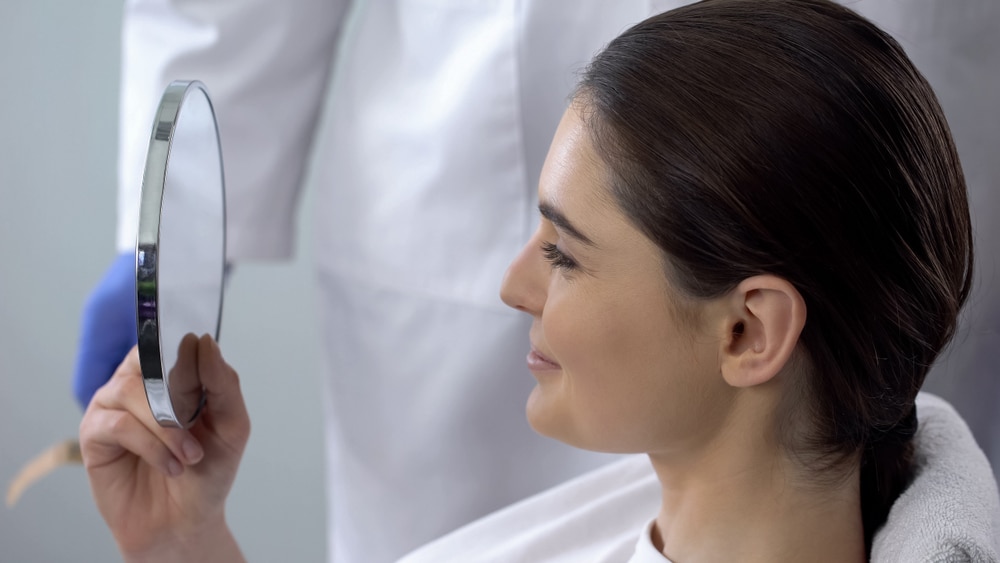Top Facial Cosmetic Surgeon Located in National Harbor, MD
Revision rhinoplasty gives you an opportunity to improve both the look and function of your nose when a previous rhinoplasty surgery didn't give you the results you hoped for. Sometimes healing creates unexpected changes, or you’re still dealing with cosmetic and breathing concerns. Because a second surgery is more complex, it requires an experienced plastic surgeon with technical expertise and artistic vision.
Bella Cosmetic Surgery, based in National Harbor, Maryland, welcomes patients from Alexandria, Washington, DC, and beyond. Under the care of board-certified surgeons Dr. Anya Costeloe and Dr. Michael Chiaramonte, you’ll receive attentive treatment from start to finish.
Reasons You Might Consider Revision Rhinoplasty
You might choose revision rhinoplasty if you are dealing with:
- Nostril irregularities or asymmetry
- Breathing difficulties after your first surgery
- A septal perforation or tear
- Cosmetic concerns
- Bone or cartilage problems caused by the initial procedure
Are You a Candidate?
If your first rhinoplasty left you unhappy with the outcome, revision may be an option. During your consultation, we will review your medical history, talk through your goals, and examine your nose closely.
It’s also important to be emotionally ready and prepared for the recovery process, since revision surgery can be more involved. Together, we will decide if this procedure makes sense for you.

What to Expect During the Procedure
Revision rhinoplasty is usually performed as an outpatient surgery with either general anesthesia or deep sedation. Because prior surgery changes the nasal structure, we often use an open technique that gives better visibility and precision.
In some cases, extra support is needed, so cartilage may be taken from your septum, ear, or rib. For smaller irregularities, injectable fillers can sometimes help, but natural cartilage grafts tend to provide more reliable results. Surgery typically lasts two and a half to four hours, depending on how complex your case is.
Risks to Be Aware Of
Every surgery carries risks, and revision rhinoplasty is no exception. Potential complications can include:
- Bleeding or infection
- Injury to the septum
- Skin irritation or tissue damage
- Nasal blockage from swelling
- Anesthesia-related issues
Because revision surgery involves scar tissue and altered nasal anatomy, it is more challenging than a first-time rhinoplasty. That is why choosing a surgeon with extensive training and experience is so important.
Recovery and Healing
After surgery, you can expect swelling, bruising, and some discomfort for about five to seven days. Medication can help you stay comfortable, and if nasal packing is used, it's typically removed within two days. Bruising and swelling will get better within two weeks, although subtle refinements in your appearance will continue as your nose heals over the next several months.
You should keep your head elevated during the first few days and avoid strenuous activity for about 10 days to two weeks. Most people return to work and daily activities once the swelling goes down. While you will notice changes right away, your nose will continue to refine over the course of a year.
Why Choose Bella Cosmetic Surgery
Revision rhinoplasty is one of the most complex procedures in plastic surgery, which is why having a surgeon with advanced facial and ENT training matters. Dr. Anya Costeloe is board-certified in both Facial Plastic Surgery and Otolaryngology, giving her unique expertise in the structures of the nose, sinuses, and airway. She has dedicated her career to procedures involving the face, head, and neck, making her especially well-suited to handle the challenges of revision cases.
Alongside Dr. Costeloe, you’ll also have the support of Dr. Michael Chiaramonte, a board-certified plastic surgeon with more than 20 years of experience and fellowship training from Johns Hopkins Hospital. Together, they bring a team-based approach that emphasizes safety, clear communication, and outcomes that fit your needs.
Frequently Asked Questions
How Long Should You Wait After Your First Rhinoplasty Before Considering Revision Surgery?
Most surgeons recommend waiting at least 12 months after your first rhinoplasty before scheduling a revision. This waiting period allows swelling to fully resolve and scar tissue to soften so your surgeon has a clear view of the final outcome.
In some cases, minor adjustments may be discussed earlier, but most meaningful revisions are safest once your nose has completely healed.
How Does the Cost of Revision Rhinoplasty Compare to the Initial Procedure?
Revision rhinoplasty is typically more expensive than a first rhinoplasty. The surgery often takes longer, requires more advanced techniques, and may involve cartilage grafting or other complex steps to rebuild nasal structures.
Costs vary depending on the extent of correction needed, surgeon expertise, and surgical facility fees. A consultation will give you a personalized estimate based on your specific needs.
What Lifestyle Changes or Precautions Help Support Healing After Revision Rhinoplasty?
Good preparation and aftercare make a big difference in your healing. To support recovery, you should:
- Avoid smoking and alcohol, which slow the healing process.
- Eat a nutrient-rich diet to promote tissue repair.
- Keep your head elevated while resting during the first week.
- Avoid strenuous exercise or heavy lifting for at least two weeks.
- Use sun protection, as your nose will be more sensitive after surgery.
- Follow your surgeon’s aftercare instructions closely, including medication use and follow-up visits.
Contact Bella Cosmetic Surgery
Revision rhinoplasty is a delicate procedure. At Bella Cosmetic Surgery, you will be cared for by board-certified surgeons who understand the science and the art of nasal surgery.
If you are in Alexandria, Washington, DC, or the surrounding Maryland and Virginia areas, call 301-567-6767 to schedule your consultation.
